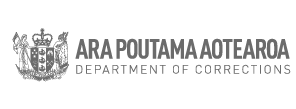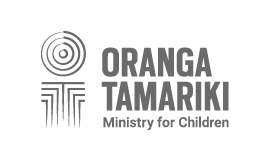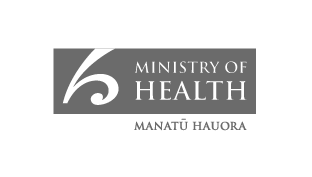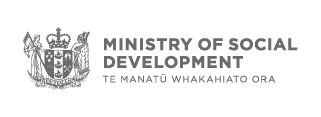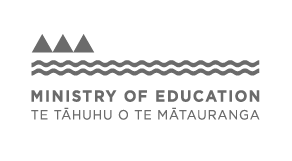13 July 2023
The ministerially appointed independent tangata whenua rōpū, Te Pūkotahitanga monitors how Te Aorerekura is delivered, especially the strategies and policies that impact iwi, hapū, and hapori Māori.
One powerful strength of the collective is access to a knowledge bank of mātauranga Māori specific to the rohe members come from. Te Pūkotahitanga chair Dr Maria Baker, with a mandate agreed by the rōpū, has set out in 2023 to reclaim restorative wisdom around violation and kōrero through initiating regional wānanga across the motu.
The inaugural session was held in Taranaki at Muru Raupatu Marae with the blessing of Te Ātiawa and organised by Te Pūkotahitanga member, Amokura Panoho. Given the whakapapa of the whenua that was scarred by the atrocities at Parihaka, it couldn’t have been a more apt location to delve into reclaiming our language around harm and recovery.
What wisdom did the whanaunga in our membership and whānau of Taranaki gift to strengthen our kaupapa serving Te Aorerekura?
It unfolded in layers, bound in tikanga. The gateway into the rohe started with kōrero by kaumatua Anaru Wilkie from Puketapu hapū. He shared about Te Hono, the New Plymouth Airport Terminal awarded by the United Nations for decolonising architecture and telling the love story of Tamarau and Rongoueroa in the design. His whakaaro honoured the birthplace of Awanuiarangi – the eponymous ancestor of Te Ātiawa. The physical structure of the building symbolises the process of healing and righting the wrongs of the past. The following day, Te Pūkotahitanga gathered with Puke Ariki Kaumatua, Matua Hone Niwa for karakia before the iconic 5 storey mural(external link) of mana wahine, the late Hana Te Hemara.
She was a member of Ngā Tamatoa and Te Reo Māori Society. Her portrait emblazons the entire exterior of the Puke Ariki Library and overlays the original kupu of the infamous 1972 te reo Māori petition. Whāea Hana knew the restorative value of reclaiming te reo Māori. She was the driving force behind a 33,000-signature petition handed over at Parliament advocating for it to be taught in the New Zealand curriculum.
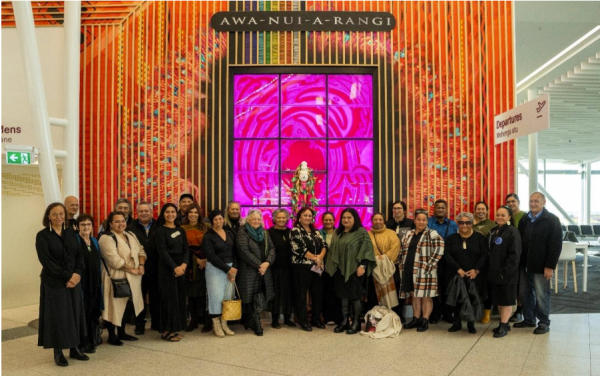
Te Pūkotahitanga with wānanga whānau who members brought with them at Te Hono

Minister Davidson on zoom at Mutu Raupatu Marae, Taranaki
Wānanga followed at Muru Raupatu Marae, featuring a range of speakers kanohi ki te kanohi. plus Minister Davidson by Zoom to share her kōrero and mihi the presenters.
“What does protecting our whakapapa really look like? We can raise our truth and get help to get healing. We do have the mana from Ranginui, from Papatūānuku and eons of whakapapa. We are worthy of the utmost protection. That is the whanaungatanga iho we should be working towards,” she said.
Highlights of the wānanga included the GM Partnerships, PKW Trust and past Chair of Parihaka Papakāinga Trust, lawyer Puna Wano Bryant who shared reo and whakapapa kōrero about He Puanga Haeata(external link) – the Parihaka-Crown Reconciliation Legislation.
“Puanga to signify the Māori New Year and star Riegel that starts to move and sits above Maunga Taranaki at this time of year. To remember those that have passed and haeata to welcome the new dawn, a new day as prophesised,” Puna said. She spoke about justice which is “to restore rangatiratanga, the divine voice of Māori in this nation and to decolonise and deconstruct the spaces we all work within”.
For Te Ātiawa, justice and peace go hand-in-hand together according to Puna. “Battle the enemy and forces of darkness with peace. We activate peace through our actions, not by being passive, or subservient, but by choosing a non-violent response to Crown violence.” She explained the Taranaki kupu for peace is ‘rongomau’. Its origins link to the God of peace and kai. “You can’t be at war when you’re cultivating in the garden. The first thing you see when you drive into Parihaka is the garden on the left and the urupa. It’s a constant reminder,” she said.
“Rongomau is a deliberate collective commitment to peaceful action. Why? To achieve rangatiratanga. That’s what it’s all about.” Te Pūkotahitanga heard more about the uniqueness of kupu used in the area, the whakapapa stories that uncovered the impact of violation to Māori in an iwi context and what strategies have been used to support whānau to prevent and stop violence. When behaviour and voices start to escalate, Puna shared that one of the tikanga her iwi adopted was to stand on their feet in silence. An immediate signal to others to de-escalate.
Her kōrero was poignant, wise, and symbolic. Teaching why whānau of Parihaka wear the raukura in their hair, the three white feathers, the tohu of peace. “A phenomenon occurred, the toroa not a common resident in Taranaki, landed at Parihaka leaving feathers before flying away. We wear these as a symbol of resistance and resilience today.”

Puna Wano Bryant at Mutu Raupatu Marae
“I encourage you on your journey of decolonisation and deconstruction to use our tupuna wisdom, our ways, our words, our voice and I honour you all today for your mahi.” Puna was followed by her whanaunga, Project Operations Manager of the Taranaki Mounga, Te Kāhui(external link), Ngahina Capper who spoke about how whānau have been impacted by connecting with taiao. “Being on the Mounga has changed the shape of their world. It is essential for the health and well-being of our people. Remove the obstacles and they’ll thrive,” said Ngahina. He shared his own transformational story as an urban Māori reconnecting himself and his whānau back to ancestral lands and Papakāinga in Taranaki after living many years in Western Australia.
While studying for his Masters, he organised wānanga as part of his research and started healing ancestral wounds in the process with his own tamariki.
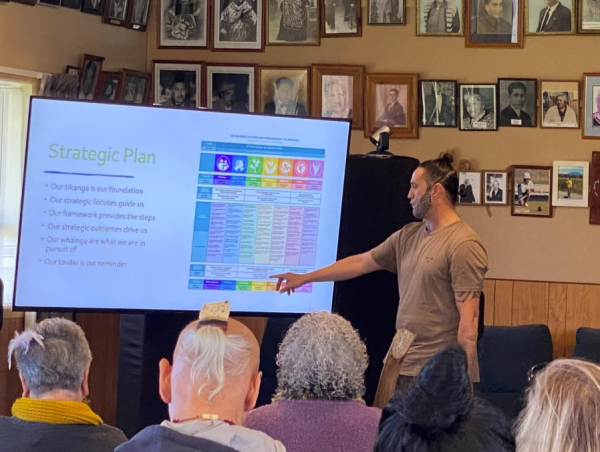
Ngahina Capper at Mutu Raupatu Marae
“We wanted to teach our kids, where does the mamae come from? Land confiscation, Māori disenfranchisement, and disconnection…Our children lead this discussion, so they understand why we need transformational change.” That’s resulted in his whānau (as uri of mana whenua) successfully buying returned land that was previously confiscated. They’ve even designed a framework which is their vision map for the future. “We’ve essentially come home,” Ngahina said, literally and figuratively. Te Pūkotahitanga members, Poata Watene and Kim Eriksen-Downs also presented. “I don’t subscribe to a one size fits all for whatever the transformation of violation is. Any violation is a transgression against whakapapa. So, it requires many solutions and an intergenerational view of those solutions. There are many different facets to it,” Kim said.
The day culminated with the rōpū exploring te reo Māori within our mahi tukino (family violence) and sharing whakaaro on kupu associated with violation at all its levels.
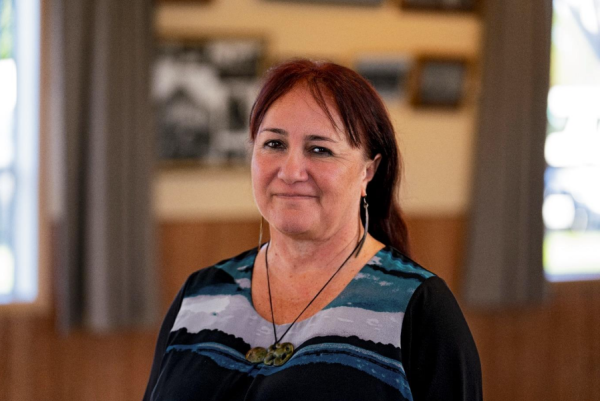
Te Pūkotahitanga Chair, Dr Maria Baker at Mutu Raupatu Marae
Te Pūkotahitanga Chair, Dr Maria Baker reinforced that the role of the tangata whenua advisory rōpū is very much to represent the tangata whenua voice and why the wānanga is invaluable. “Some of the kōrero in the places that our poets, our researchers, our musos, our writers, our practitioners, our evaluators, and our healers are working in, unfortunately a lot of the time, is being interrupted by another ao. So, it has been our privilege to come here to Taranaki for our first wānanga.”
Matariki season heralds the time for the next regional hui that will be hosted in Kaikohe, Te Tai Tokerau with Ngāpuhi. Then the rōpū heads down to Kaikoura at the end of the year to connect with kaimahi and wānanga whānau in Te Waipounamu.
To find out more about the kaupapa of Te Pūkotahitanga, watch here(external link).
Last modified:
